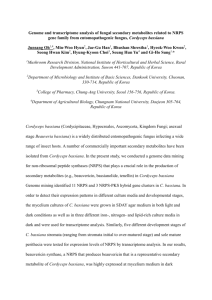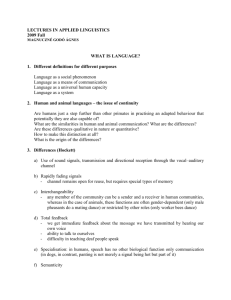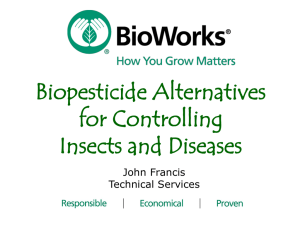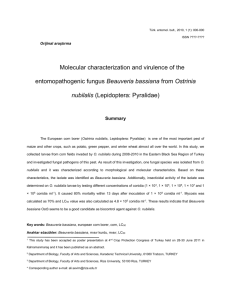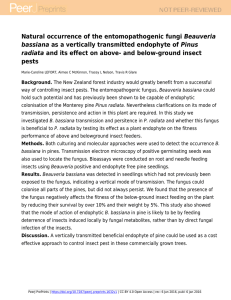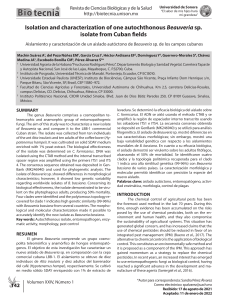2008_IOBC_2008_ etherlands_Shipp_et_al
advertisement
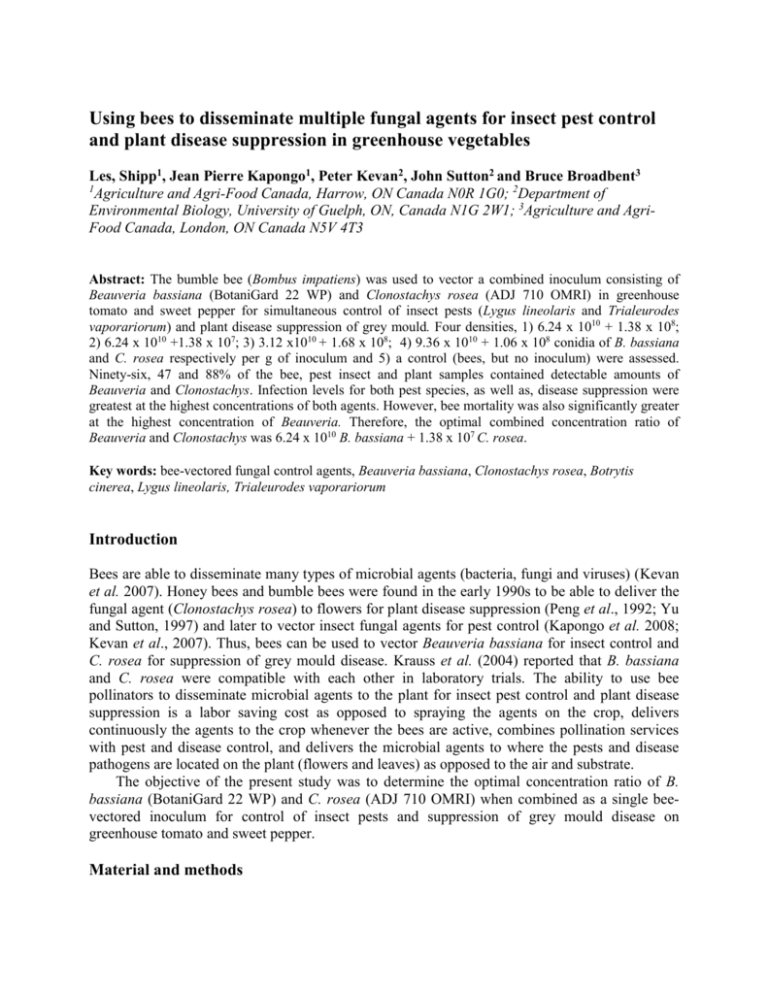
Using bees to disseminate multiple fungal agents for insect pest control and plant disease suppression in greenhouse vegetables Les, Shipp1, Jean Pierre Kapongo1, Peter Kevan2, John Sutton2 and Bruce Broadbent3 1 Agriculture and Agri-Food Canada, Harrow, ON Canada N0R 1G0; 2Department of Environmental Biology, University of Guelph, ON, Canada N1G 2W1; 3Agriculture and AgriFood Canada, London, ON Canada N5V 4T3 Abstract: The bumble bee (Bombus impatiens) was used to vector a combined inoculum consisting of Beauveria bassiana (BotaniGard 22 WP) and Clonostachys rosea (ADJ 710 OMRI) in greenhouse tomato and sweet pepper for simultaneous control of insect pests (Lygus lineolaris and Trialeurodes vaporariorum) and plant disease suppression of grey mould. Four densities, 1) 6.24 x 1010 + 1.38 x 108; 2) 6.24 x 1010 +1.38 x 107; 3) 3.12 x1010 + 1.68 x 108; 4) 9.36 x 1010 + 1.06 x 108 conidia of B. bassiana and C. rosea respectively per g of inoculum and 5) a control (bees, but no inoculum) were assessed. Ninety-six, 47 and 88% of the bee, pest insect and plant samples contained detectable amounts of Beauveria and Clonostachys. Infection levels for both pest species, as well as, disease suppression were greatest at the highest concentrations of both agents. However, bee mortality was also significantly greater at the highest concentration of Beauveria. Therefore, the optimal combined concentration ratio of Beauveria and Clonostachys was 6.24 x 1010 B. bassiana + 1.38 x 107 C. rosea. Key words: bee-vectored fungal control agents, Beauveria bassiana, Clonostachys rosea, Botrytis cinerea, Lygus lineolaris, Trialeurodes vaporariorum Introduction Bees are able to disseminate many types of microbial agents (bacteria, fungi and viruses) (Kevan et al. 2007). Honey bees and bumble bees were found in the early 1990s to be able to deliver the fungal agent (Clonostachys rosea) to flowers for plant disease suppression (Peng et al., 1992; Yu and Sutton, 1997) and later to vector insect fungal agents for pest control (Kapongo et al. 2008; Kevan et al., 2007). Thus, bees can be used to vector Beauveria bassiana for insect control and C. rosea for suppression of grey mould disease. Krauss et al. (2004) reported that B. bassiana and C. rosea were compatible with each other in laboratory trials. The ability to use bee pollinators to disseminate microbial agents to the plant for insect pest control and plant disease suppression is a labor saving cost as opposed to spraying the agents on the crop, delivers continuously the agents to the crop whenever the bees are active, combines pollination services with pest and disease control, and delivers the microbial agents to where the pests and disease pathogens are located on the plant (flowers and leaves) as opposed to the air and substrate. The objective of the present study was to determine the optimal concentration ratio of B. bassiana (BotaniGard 22 WP) and C. rosea (ADJ 710 OMRI) when combined as a single beevectored inoculum for control of insect pests and suppression of grey mould disease on greenhouse tomato and sweet pepper. Material and methods The trials were conducted during 2007 in two greenhouse compartments (7 x 13 m) with two or three fine-mesh screened cages (520 x 240 x 220 cm high) per greenhouse. Each cage contained 64 potted sweet pepper or tomato plants with a minimum of two flower sets per plant and one colony (50 workers and 1 queen) of bumble bees (Bombus impatiens). The cages were maintained at 21-23oC and 80-85% RH throughout the trials. A completely randomized design was applied for the five treatments with three replications over time. The treatments were: 1) 6.24 x 1010 + 1.38 x 108; 2) 6.24 x 1010 + 1.38 x 107; 3) 3.12 x1010 + 1.68 x 108; 4) 9.36 x 1010 + 1.06 x 108 conidia of B. bassiana and C. rosea respectively per g of inoculum; and 5) a control (bees, but no inoculum). Each colony of bumble bees was introduced one day after the plants were placed in the cages to allow for acclimation to their hive and the cage. On day 2, 256 adult Lygus lineolaris were released per treatment for the pepper trials and 1000 adult greenhouse whiteflies, Trialeurodes vaporariorum, in the tomato trials. On the same day, the leaves and flowers of 12 randomly selected plants per treatment were artificially inoculated with spores of Botrytis cinerea (grey mould pathogen). Wooden dispensers filled with the appropriate inoculum (empty dispenser in the control) were placed in front of the hives on day 3. The first sample (50 adult Lygus and T. vaporariorum, and 24 flowers and leaves) was collected on day 6 after which the dispensers were removed. The dispensers were refilled and replaced day 10, and a second sample was collected three days later. Five bees were also sampled from each treatment at each sampling date to determine the amount of Beauveria and Clonostachys that the bees were carrying. Ten Lygus and T. vaporariorum per sample were surface sterilized following Shipp et al. (2003) to estimate internal infection levels. Samples were then placed on water agar plates, incubated at 25oC and 80% RH for five days before checking for sporulation using a dissecting microscope. Another 10 Lygus and T. vaporariorum, 5 bees, and 12 flowers and leaves per treatment sample were washed to determine the amount of conidia that individual pests or plant parts carried/received using the protocol of Kapongo et al. (2008). The remaining Lygus and T. vaporariorum were used to assess the percentage mortality caused by Beauveria. Each insect was individually kept for seven days in an aerated Petri dish (Lygus) or an aerated sealed plastic vial (whitefly) containing organic lettuce or the growing point of a tomato plant, respectively as a food source. All bioassay cages were inspected daily for insect death. The appearance of white mycelium on cadavers indicated Beauveria infection. The remaining 12 leaves and flowers were placed individually on moistened filter paper in sealed Petri dishes and incubated for 14 days at 25 ºC and 80% RH. After incubation, ten 10cm diameter disks were cut at random sites on each leaf and flower by means of cork borers that were surface-disinfected in sodium hypochlorite and washed in sterile water before each excision. Sporulation of grey mould was assessed following the protocol of Sutton et al. (2002) using a dissecting microscope to determine the incidence and percentage area of tissue pieces with conidiophores. Mortality of the bumble bees exposed to the five treatments was determined after the second sampling. Each bumble bee colony was transferred back into the commercial hive boxes and fed pollen patties mixed with 50% wt/wt sugar solution for five weeks. The percentage of bumble bee mortality was recorded weekly. Results and discussion Ninety-six, 47 and 88% of the bee, pest insect and plant samples contained detectable concentrations of B. bassiana and C. rosea for both crops for all treatments, except the control treatment in which neither fungal agent was ever detected. The amount of Beauveria per T. vaporariorum sample ranged from 21-90 conidia per adult. For Lygus, the conidia counts varied from 119-401 per individual adult. In the mortality bioassays for the insect pests, the bumble-bee disseminated inoculum caused a mortality range of 53-74% among the four Beauveria treatments for the Lygus samples (Figure 1). Fifty-six to 83% of the dead Lygus exhibited mycosis. No mycosis was found in the control samples. Internal infection levels ranged from 31-50%. A similar relationship was found for T. vaporariorum (Figure 1). Bee mortality was not significantly different among T1 to T3 and T5 (control). For T4 (highest Beauveria concentration), bee mortality ranged from 47-59% between the two crops. Grey mould suppression for the flower and leaf samples ranged from 38-79% for both crops (Figure 2). Results obtained from this study were similar to data reported when both fungal agents were evaluated separately. Insect mortality in greenhouse pepper Whitefly 90 80 70 60 50 40 30 20 10 0 b a b A b B B T1 Bumble bee c B T2 % Mortality % Mortality Insect mortality in greenhouse tomato B T3 T4 90 80 70 60 50 40 30 20 10 0 Bumble bee a a A B B b B B T1 T5 Lygus a a T2 T3 T4 T5 Treatments Treatments Figure 1. Mean (± SE) percentage mortality of insects when exposed to the five bumble-bee vectored densities of the combined B. bassiana/C. rosea inoculum in greenhouse cage trials of tomato and pepper for insect pest and plant disease control. Treatments assigned the same letter are not significantly different (protected LSD, P ≤ 0.05) using F-test. Grey mould suppression on pepper 90 80 70 60 50 40 30 20 10 0 Leaf A A ab b T1 Flower A B T2 a b T3 Treatments T4 T5 % disease suppression % disease suppression Grey mould suppression on tomato 90 80 70 60 50 40 30 20 10 0 Leaf AB ab T1 A ab Flower A a b T2 T3 T4 B T5 Treatments Figure 2. Mean (± SE) percentage of grey mould suppression on flower and leaf samples from tomato and pepper when exposed to the five concentration ratios of the bumble-bee vectored B. bassiana/C. rosa inoculum. Treatments assigned the same letter are not significantly different (protected LSD, P ≤ 0.05) using F-test. In summary, the combined concentration ratio of 6.24 x 1010 + 1.38 x 107 conidia of B. bassiana and C. rosea per g of inoculum is the optimal concentration ratio for both agents for insect pest control and plant disease suppression based on pest control efficacy, disease suppression and minimal impact on bee mortality. The next step is to determine the impact of these fungal agents on non-target organisms and to conduct commercial efficacy trials. Acknowledgements Study was funded in part with a grant from the Minor Use Research Initiative, Pest Management Centre, Agriculture and Agri-Food Canada. References Kapongo, J.P., Shipp, L., Kevan, P. & Broadbent, B. 2008: Optimal concentration of Beauveria bassiana vectored by bumble bees in relation to pest and bee mortality in greenhouse tomato and sweet pepper. BioControl: (in press). Kevan, P.G., Sutton, J. & Shipp, L. 2007: Pollinators as vectors of biocontrol agents – the B52 story. In: Biological Control – A Global Perspective, eds. C. Vincent, M.S. Goettel & G. Lazarovits, CABI International, Oxfordshire, UK, 319-327. Krauss, U., Hidalgo, E., Arroyo, C. & Piper, S.R., 2004: Interaction between the entomopathogens Beauveria bassiana, Metarhizium anisopliae and Paecilomyces fumosoroseus and the mycoparasites Clonostachys spp., Trichoderma harzianum and Lecanicillium lecanii. Biocontrol Science and Technology 14: 331-346. Peng, G., Sutton, J. C. & Kevan, P. G. 1992: Effectiveness of honeybees for applying the biocontrol agent Gliocladium roseum to strawberry flowers to suppress Botrytis cinerea. Canadian Journal of Plant Pathology 14: 117-129. Shipp, J.L., Zhang, Y., Hunt, D.W. & Ferguson, G. 2003: Influence of humidity in greenhouse microclimate on the efficacy of Beauveria bassiana (Balsamo) for control of greenhouse arthropod pests. Environmental Entomology 32: 1154-1163. Sutton, J.C., Liu, W., Huang, R. & Owen-Going, N. 2002: Ability of Clonostachys rosea to establish and suppress sporulation of Botrytis cinerea in deleafed stems of hydroponic greenhouse tomatoes. Biocontrol Science and Technology 12: 413-425. Yu, H. & Sutton, J. C. 1997: Effectiveness of bumble bees and honey bees for delivering inoculum of Giocladium roseum to raspberry flowers to control Botrytis cinerea. Biological Control 10: 113-122.





